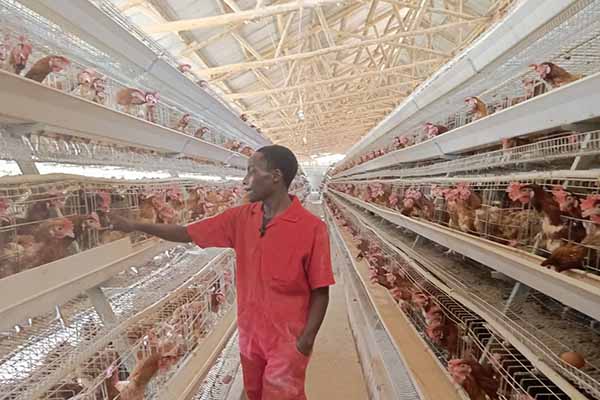Comparison of Tanzanian Chicken Farms Before and After Automation Transformation
Time : 2025-07-02
The poultry industry in Tanzania has experienced significant growth over the past few years, driven by the increasing demand for poultry products in the domestic and international markets. Automation has played a pivotal role in transforming the industry, particularly in chicken farming. This article provides a comprehensive comparison of Tanzanian chicken farms before and after the automation transformation, highlighting the changes in productivity, efficiency, and sustainability.
Introduction
Tanzania has a growing population, which has led to a surge in the demand for poultry products. To meet this demand, traditional chicken farming practices have been replaced by modern, automated systems. This shift has had a profound impact on the industry, resulting in improved productivity and efficiency. In this article, we will discuss the various aspects of Tanzanian chicken farms before and after the automation transformation.
Traditional Chicken Farming Practices
Before the advent of automation, Tanzanian chicken farms were predominantly based on traditional practices. These farms were characterized by the following features:
1. Manual Labor: Traditional chicken farming involved extensive manual labor, with farmers engaging in tasks such as feeding, cleaning, and vaccination.
2. Limited Technology: These farms had limited access to modern technology, resulting in lower productivity and efficiency.
3. Limited Scale: Most traditional chicken farms were small-scale operations, which made it challenging to meet the growing demand for poultry products.
4. Health Risks: The lack of proper biosecurity measures increased the risk of disease outbreaks among the chickens.
5. Environmental Impact: Traditional chicken farming practices were not environmentally friendly, as they led to excessive waste and pollution.
Automation Transformation
The automation transformation in Tanzanian chicken farming has brought about several changes, which have positively impacted the industry. Some of the key aspects of this transformation include:
1. Automated Feeding Systems: Automated feeding systems have replaced manual feeding, ensuring that chickens receive the right amount of feed at the right time. This has led to improved growth rates and better overall health.
2. Automatic Egg Collection: Automatic egg collection systems have reduced the risk of broken eggs and labor costs associated with manual collection.
3. Automated Climate Control: Climate control systems have been introduced to maintain optimal temperatures and humidity levels, creating a favorable environment for chicken growth.
4. Automated Water Supply: Automated water supply systems ensure that chickens have access to clean water at all times, which is crucial for their health and productivity.
5. Advanced Biosecurity Measures: Biosecurity measures have been enhanced through the use of automated systems, reducing the risk of disease outbreaks.
Impact on Productivity
The automation transformation has significantly improved productivity in Tanzanian chicken farms. Some of the key benefits include:
1. Increased Growth Rates: Automated systems provide optimal conditions for chicken growth, resulting in higher growth rates and better feed conversion ratios.
2. Reduced Labor Costs: Automated systems have reduced the need for manual labor, leading to lower labor costs.
3. Increased Egg Production: The use of automated systems has resulted in higher egg production, meeting the growing demand for poultry products.
4. Enhanced Biosecurity: Automated systems have improved biosecurity measures, reducing the risk of disease outbreaks.
Impact on Efficiency
The automation transformation has also improved efficiency in Tanzanian chicken farms. Some of the key benefits include:
1. Reduced Waste: Automated systems have minimized waste, leading to more sustainable operations.
2. Lower Energy Consumption: Automated systems have reduced energy consumption, making chicken farming more environmentally friendly.
3. Improved Data Collection: Automated systems have enabled better data collection, allowing farmers to make informed decisions and optimize their operations.
4. Reduced Production Costs: The use of automated systems has resulted in lower production costs, leading to increased profitability.
Impact on Sustainability
The automation transformation has contributed to the sustainability of Tanzanian chicken farming. Some of the key aspects include:
1. Reduced Environmental Impact: Automated systems have minimized the environmental impact of chicken farming, such as pollution and waste.
2. Improved Animal Welfare: Automated systems provide a more comfortable environment for chickens, leading to better animal welfare.
3. Community Development: The increased profitability of chicken farming has led to the creation of jobs and improved the living standards of the local community.
Conclusion
The automation transformation has had a profound impact on Tanzanian chicken farming, leading to improved productivity, efficiency, and sustainability. By adopting modern, automated systems, Tanzanian chicken farmers have been able to meet the growing demand for poultry products while ensuring the well-being of their chickens and the environment. As the industry continues to evolve, it is essential for farmers to stay abreast of the latest technological advancements to maintain a competitive edge.












